Bumblebees (Bombus terrestris) Improve ‘Hass’ Avocado (Persea americana) Pollination
Abstract
:1. Introduction
2. Materials and Methods
2.1. Hive Introduction
2.2. Tree Marking to Measure Bee Activity, Yield, and Fruit Size
2.3. HB and BB Foraging Activity
2.4. Yield and Fruit Weight
2.5. Pollination Rate and Number of Pollen Grains on the Stigma
2.6. Molecular Paternity Analysis
2.7. Statistical Analysis
3. Results
3.1. First Year—2017/18
3.2. Second Year—2018/19
3.2.1. Bee Activity
3.2.2. Yields
3.3. Third Year—2019/20
3.3.1. Bee Activity
3.3.2. Yield
3.3.3. Pollination Rate
3.3.4. Molecular Paternity Analysis
4. Discussion
5. Conclusions
Supplementary Materials
Author Contributions
Funding
Institutional Review Board Statement
Informed Consent Statement
Data Availability Statement
Acknowledgments
Conflicts of Interest
References
- Alcaraz, M.; Hormaza, J. Reproductive biology of avocado (Persea americana). Acta Hortic. 2019, 1231, 23–28. [Google Scholar] [CrossRef]
- Salazar-Garcia, S.; Garner, L.C.; Lovatt, C.J. Reproductive biology. In The Avocado: Botany, Production and Uses, 2nd ed.; Schaffer, B., Wolstenholm, N.B., Whiley, A.W., Eds.; CABI Publishing: Wallingford, UK, 2013; pp. 118–167. [Google Scholar]
- Dymond, K.; Celis-Diez, J.L.; Potts, S.G.; Howiett, B.G.; Willcox, B.K.; Garratt, M.P.D. The role of insect pollinators in avocado production: A global review. J. Appl. Entomol. 2021, 145, 369–383. [Google Scholar] [CrossRef]
- Ish-Am, G.; Eisikowitch, D. The behaviour of honeybees (Apis mellifera) visiting avocado (Persea americana) flowers and their contribution to its pollination. J. Apic. Res. 1993, 32, 175–186. [Google Scholar] [CrossRef]
- Ish-Am, G.; Eisikowitch, D. Low attractiveness of avocado (Persea americana Mill.) flowers to honeybees (Apis mellifera L.) limits fruit set in Israel. J. Hortic. Sci. Biotechnol. 1998, 73, 195–204. [Google Scholar] [CrossRef]
- Ish-Am, G.; Regev, Y.; Peterman, Y.; Lahav, E.; Degani, C.; El-batzri, R.; Gazit, S. Improving avocado pollination with bumblebees: 3 seasons summary. Calif. Avocado Soc. 1998, 82, 119–135. [Google Scholar]
- Gazit, S.; Degani, C. Reproductive biology. In The Avocado: Botany, Production and Uses; Whiley, A.W., Schaffer, B., Wolstenholm, N.B., Eds.; CABI Publishing: Wallingford, UK, 2002; pp. 101–133. [Google Scholar]
- Afik, O.; Dag, A.; Kerem, Z.; Shafir, S. Analyses of avocado (Persea americana) nectar properties and their perception by honeybees (Apis mellifera). J. Chem. Ecol. 2006, 32, 1949–1963. [Google Scholar] [CrossRef]
- Afik, O.; Dag, A.; Kerem, Z.; Shafir, S. The effect of avocado (Persea americana) nectar composition on its attractiveness to honeybees. Apidologie 2006, 37, 317–325. [Google Scholar] [CrossRef] [Green Version]
- Schaffer, B.A.; Wolstenholme, B.N.; Whiley, A.W. The Avocado: Botany, Production and Uses; CABI: Wallingford, UK, 2013. [Google Scholar]
- Davenport, T.L. Avocado Flowering. Hortic. Rev. 2011, 8, 257–289. [Google Scholar] [CrossRef]
- Garibaldi, L.A.; Steffan-Dewenter, I.; Winfree, R.; Aizen, M.A.; Bommarco, R.; Cunningham, S.A.; Kremen, C.; Carvalheiro, L.G.; Harder, L.D.; Afik, O.; et al. Wild Pollinators Enhance Fruit Set of Crops Regardless of Honey Bee Abundance. Science 2013, 339, 1608–1611. [Google Scholar] [CrossRef] [PubMed]
- Read, S.; Howlett, B.; Jesson, L.; Pattemore, D. Insect visitors to avocado flowers in the Bay of Plenty, New Zealand. N. Z. Plant Prot. 2017, 70, 38–44. [Google Scholar] [CrossRef] [Green Version]
- Doyle, T.; Hawkes, W.L.S.; Massy, R.; Powney, G.D.; Menz, M.H.M.; Wotton, K.R. Pollination by hoverflies in the Anthropocence. Proc. R. Soc. B 2020, 287, 20200508. [Google Scholar] [CrossRef] [PubMed]
- Ish-Am, G.; Barrientos-Priego, A.F.; Castaneda-Vildozola, A.; Gazit, S. Avocado (Persea americana Mill.) pollinators in its region of origin. Rev. Chapingo Ser. Hortic. 1999, 5, 137–143. [Google Scholar]
- Heinrich, B. Bumblebee Economics; Harvard University Press: Cambridge, MA, USA, 2004. [Google Scholar]
- Free, J.B.; Williams, I.H. The Transport of Pollen on the Body Hairs of Honeybees (Apis mellifera L.) and Bumblebees (Bombus spp. L.). J. Appl. Ecol. 1972, 9, 609. [Google Scholar] [CrossRef]
- Goodell, K.; Thomson, J.D. Comparisons of pollen removal and deposition by honeybees and bumble bees visiting apple. Acta Hortic. 1997, 437, 103–107. [Google Scholar] [CrossRef]
- Zisovich, A.H.; Goldway, M.; Schneider, D.; Steinberg, S.; Stern, E.; Stern, R.A. Adding bumblebees (Bombus terrestrisL., Hymenoptera: Apidae) to pear orchards increases seed number per fruit, fruit set, fruit size and yield. J. Hortic. Sci. Biotechnol. 2012, 87, 353–359. [Google Scholar] [CrossRef]
- Sapir, G.; Goldway, M.; Baras, Z.; Atsmon, G.; Shafir, S.; Allouche, A.; Stern, E.; Stern, R.A. Synergistic effects of bumble bees and honeybees in apple orchards increases cross pollination, seed number and fruit size. Sci. Hort. 2017, 219, 107–117. [Google Scholar] [CrossRef]
- Vicens, N.; Bosch, J. Weather-dependent pollinator activity in an apple orchard, with special reference to Osmia cornuta and Apis mellifera (Hymenoptera: Megachilidae and Apidae). Environ. Entomol. 2000, 29, 413–420. [Google Scholar] [CrossRef]
- Goulson, D. Bumblebees: Behavior, Ecology and Conservation, 2nd ed.; Oxford University Press Inc.: New York, NY, USA, 2010. [Google Scholar]
- Delaplane, K.S.; Mayer, D.F. Crop Pollination by Bees; CABI Publication: Wallingford, UK, 2000. [Google Scholar]
- Zhang, H.; Huang, J.; Williams, P.H.; Vaissière, B.E.; Zhou, Z.; Gai, Q.; Dong, J.; An, J. Managed Bumblebees Outperform Honeybees in Increasing Peach Fruit Set in China: Different Limiting Processes with Different Pollinators. PLoS ONE 2015, 10, e0121143. [Google Scholar] [CrossRef] [Green Version]
- Zhang, C.; Tateishi, N.; Tanabe, K. Pollen density on the stigma affects endogenous gibberellin metabolism, seed and fruit set, and fruit quality in Pyrus pyrifolia. J. Exp. Bot. 2010, 61, 4291–4302. [Google Scholar] [CrossRef] [Green Version]
- Stern, R.A.; Gazit, S. Lychee Pollination by the Honeybee. J. Am. Soc. Hortic. Sci. 1996, 121, 152–157. [Google Scholar] [CrossRef] [Green Version]
- Sapir, G.; Goldway, M.; Stern, R.A. Supplementing bumblebees to Mauritius lychee improves yield. Sci. Hort. 2019, 251, 162–166. [Google Scholar] [CrossRef]
- Stahl, P.; Lev Mirom, Y.; Stern, R.A.; Goldway, M. Comparing Iriet and Ettinger avocado cultivars as pollinators of Hass using SNPs for paternal identification. Sci. Hort. 2019, 248, 50–57. [Google Scholar] [CrossRef]
- Stern, R.; Eisikowitch, D.; Dag, A. Sequential introduction of honeybee colonies and doubling their density increases cross-pollination, fruit-set and yield in ‘Red Delicious’ apple. J. Hortic. Sci. Biotechnol. 2001, 76, 17–23. [Google Scholar] [CrossRef]
- Stern, R.; Goldway, M.; Zisovich, A.H.; Shafir, S.; Dağ, A. Sequential introduction of honeybee colonies increases cross-pollination, fruit-set and yield of ‘Spadona’ pear (Pyrus communisL.). J. Hortic. Sci. Biotechnol. 2004, 79, 652–658. [Google Scholar] [CrossRef]
- Alcaraz, M.; Hormaza, J.; Hormaza, I. Optimization of controlled pollination in avocado (Persea americana Mill., Lauraceae). Sci. Hortic. 2014, 180, 79–85. [Google Scholar] [CrossRef] [Green Version]
- McCracken, E.; Johansen, D.A. Plant Microtechnique. Trans. Am. Microsc. Soc. 1940, 59, 405. [Google Scholar] [CrossRef]
- Martin, F.W. Staining and Observing Pollen Tubes in the Style by Means of Fluorescence. Stain. Technol. 1959, 34, 125–128. [Google Scholar] [CrossRef]
- Rubinstein, M.; Eshed, R.; Rozen, A.; Zviran, T.; Kuhn, D.N.; Irihimovitch, V.; Sherman, A.; Ophir, R. Genetic diversity of avocado (Persea americana Mill.) germplasm using pooled sequencing. BMC Genom. 2019, 20, 379. [Google Scholar] [CrossRef]
- Pattemore, D.E.; Evans, L.E.; McBrydie, H.M.; Dag, A.; Howlett, B.G.; Cutting, B.; Goodwin, R.M. Understanding pollination processes in avocado (Persea Americana) orchards. Acta Hortic. 2021, 1299, 317–328. [Google Scholar]
- Reilly, J.R.; Artz, D.R.; Biddinger, D.; Bobiwash, K.; Boyle, N.K.; Brittain, C.; Brokaw, J.; Campbell, J.W.; Daniels, J.; Elle, E.; et al. Crop production in the USA is frequently limited by a lack of pollinators. Proc. R. Soc. B Biol. Sci. 2020, 287, 20200922. [Google Scholar] [CrossRef]
- Marqués, A.; Juan, A.; Ruiz, M.; Traveset, A.; Leza, M. Improvement of almond production using Bombus terrestris (Hymenoptera: Apidae) in Mediterranean conditions. J. Appl. Èntomol. 2019, 143, 1132–1142. [Google Scholar] [CrossRef]
- Ziv, D.; Zviran, T.; Zezak, O.; Samach, A.; Irihimovitch, V. Expression Profiling of FLOWERING LOCUS T-Like Gene in Alternate Bearing ‘Hass’ Avocado Trees Suggests a Role for PaFT in Avocado Flower Induction. PLoS ONE 2014, 9, e110613. [Google Scholar] [CrossRef] [PubMed]
- Wolf, S.; Moritz, R.F.A. Foraging distance in Bombus terrestris L. (Hymenoptera: Apidea). Apidologie 2008, 39, 419–427. [Google Scholar] [CrossRef]
- Sedgley, M.; Griffin, A. Sexual Reproduction of Tree Crops; Elsevier BV: Amsterdam, The Netherlands, 1989; pp. 204–213. [Google Scholar]
- Shoval, L.S. Pollination Rate and Pollen Tube Growth of Avocado in Relation to Yield. Master’s Thesis, The Hebrew University of Jerusalem, Rehovot, Jerusalem, 1987. [Google Scholar]
- Boldingh, H.; Alcaraz, M.; Thorp, T.; Minchin, P.; Gould, N.; Hormaza, J. Carbohydrate and boron content of styles of ‘Hass’ avocado ( Persea americana Mill.) flowers at anthesis can affect final fruit set. Sci. Hortic. 2016, 198, 125–131. [Google Scholar] [CrossRef]
- Alcaraz, M.L.; Hormaza, J.I.; Rodrigo, J. Pistil Starch Reserves at Anthesis Correlate with Final Flower Fate in Avocado (Persea americana). PLoS ONE 2013, 8, e78467. [Google Scholar] [CrossRef] [Green Version]
- Sedgley, M.; Annells, C.M. Flowering and fruit set response to temperature in the avocado cultivar ‘Hass’. Sci. Hort. 1981, 14, 27–33. [Google Scholar] [CrossRef] [Green Version]
- Degani, C.; Goldring, A.; Gazit, S.; Lavi, U. Genetic selection during the abscission of avocado fruitlets. Hort. Sci. 1986, 21, 1187–1188. [Google Scholar]
- Degani, C.; El-Batsri, R.; Gazit, S. Outcrossing rate yield and selective fruit abscission in ‘Ettinger’ and ‘Edriet’ avocado plots. J. Am. Soc. Hortic. 1987, 122, 813–817. [Google Scholar] [CrossRef]
- Degani, C.; Goldring, A.; Gazit, S.; Lavi, U. Pollen parent effect on outcrossing rate in ‘Hass’ and’ Fuerte’ avocado plots during fruit development. J. Am. Soc. Hortic. Sci. 1989, 114, 106–111. [Google Scholar]
- Drezner-Levy, T.; Shafir, S. Parameters of variable reward distributions that affect risk sensitivity of honeybees. J. Exp. Biol. 2007, 210, 269–277. [Google Scholar] [CrossRef] [Green Version]
- Waddington, K.D. Flight patterns of foraging bees relative to density of artificial flowers and distribution of nectar. Oecologia 1980, 44, 199–204. [Google Scholar] [CrossRef] [PubMed]
- Pyke, G.H. Floral Nectar: Pollinator Attraction or Manipulation? Trends Ecol. Evol. 2016, 31, 339–341. [Google Scholar] [CrossRef] [PubMed]
- Ott, J.R.; Real, L.A.; Silverfine, E.M. The Effect of Nectar Variance on Bumblebee Patterns of Movement and Potential Gene Dispersal. Oikos 1985, 45, 333. [Google Scholar] [CrossRef] [Green Version]
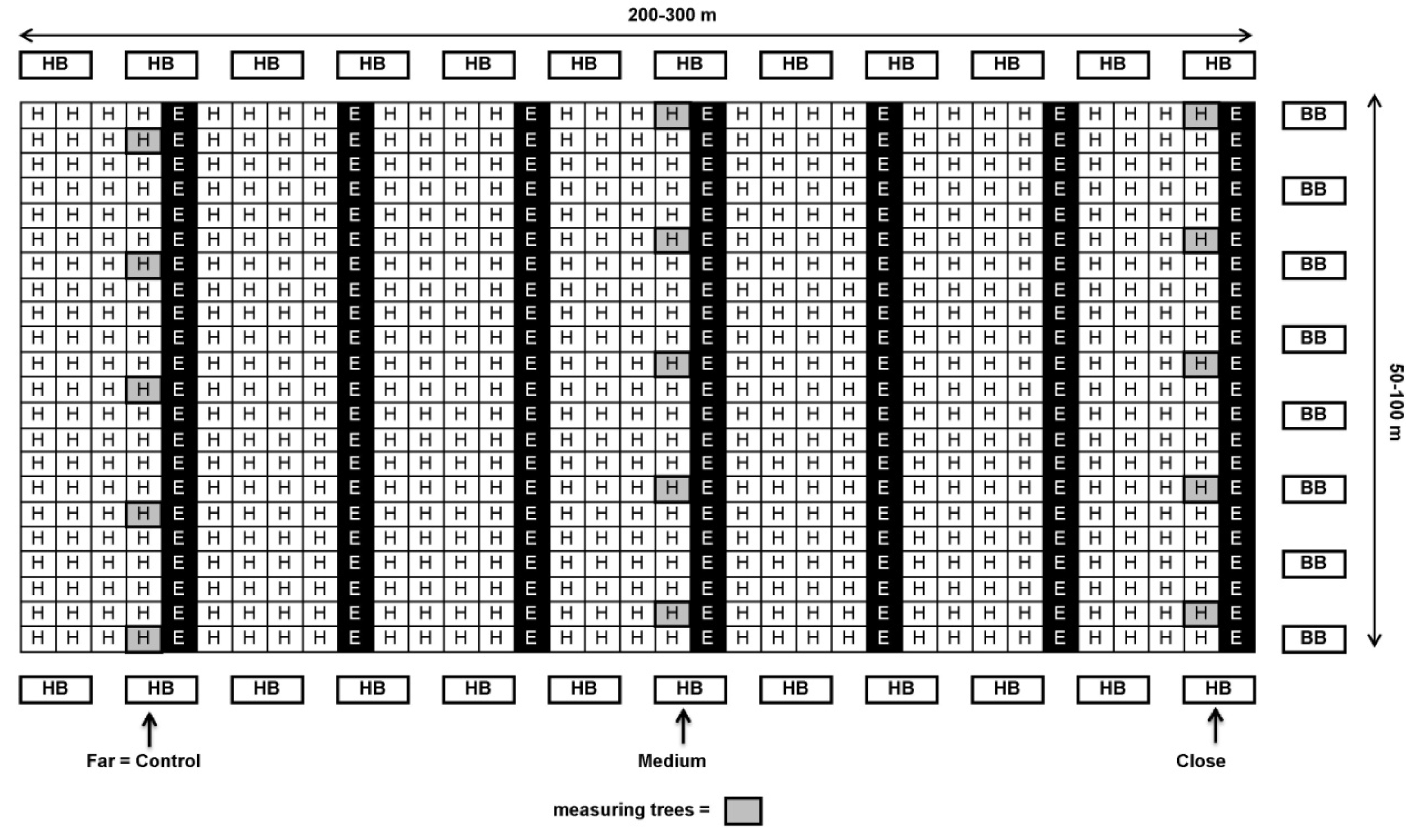
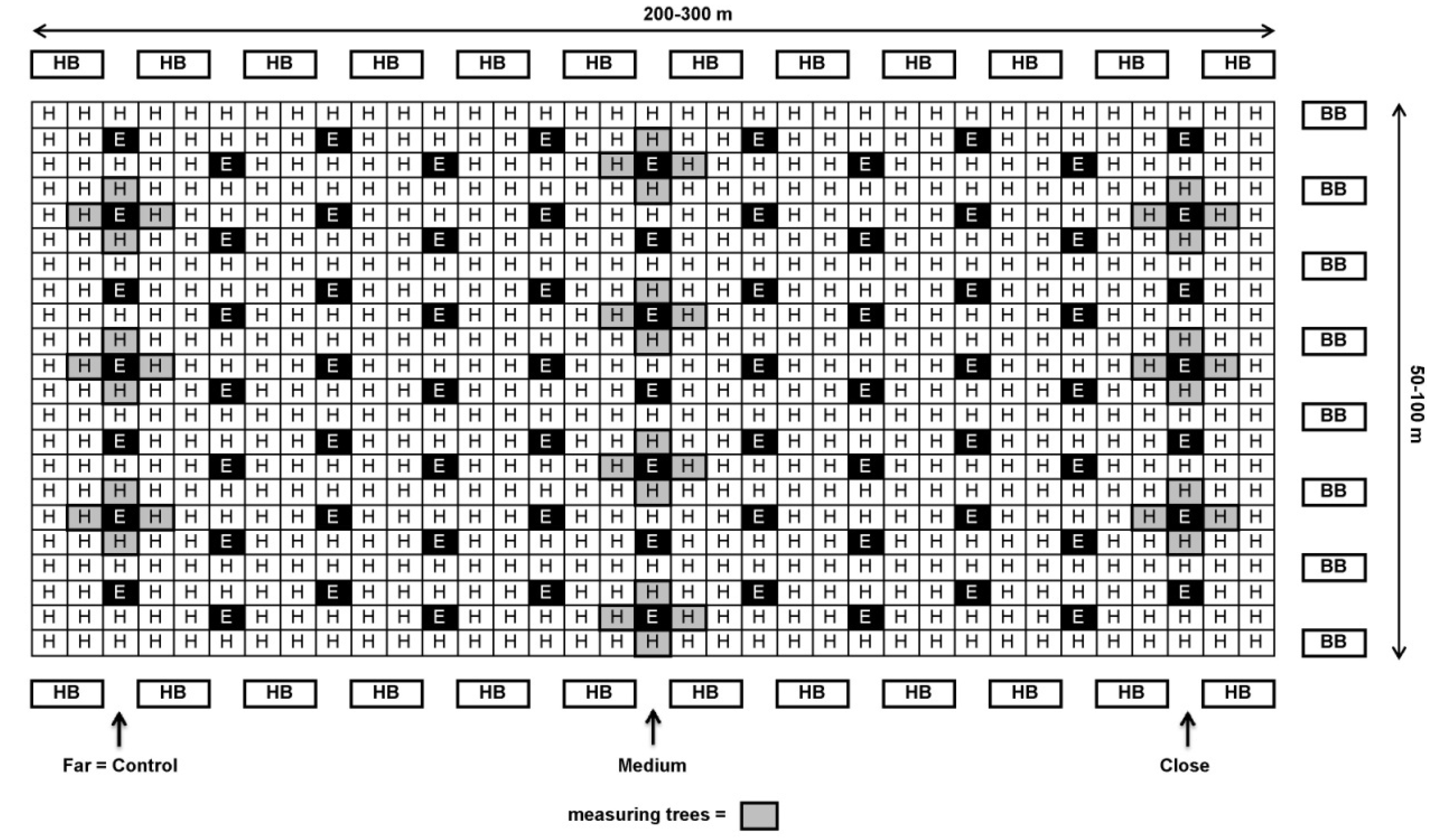
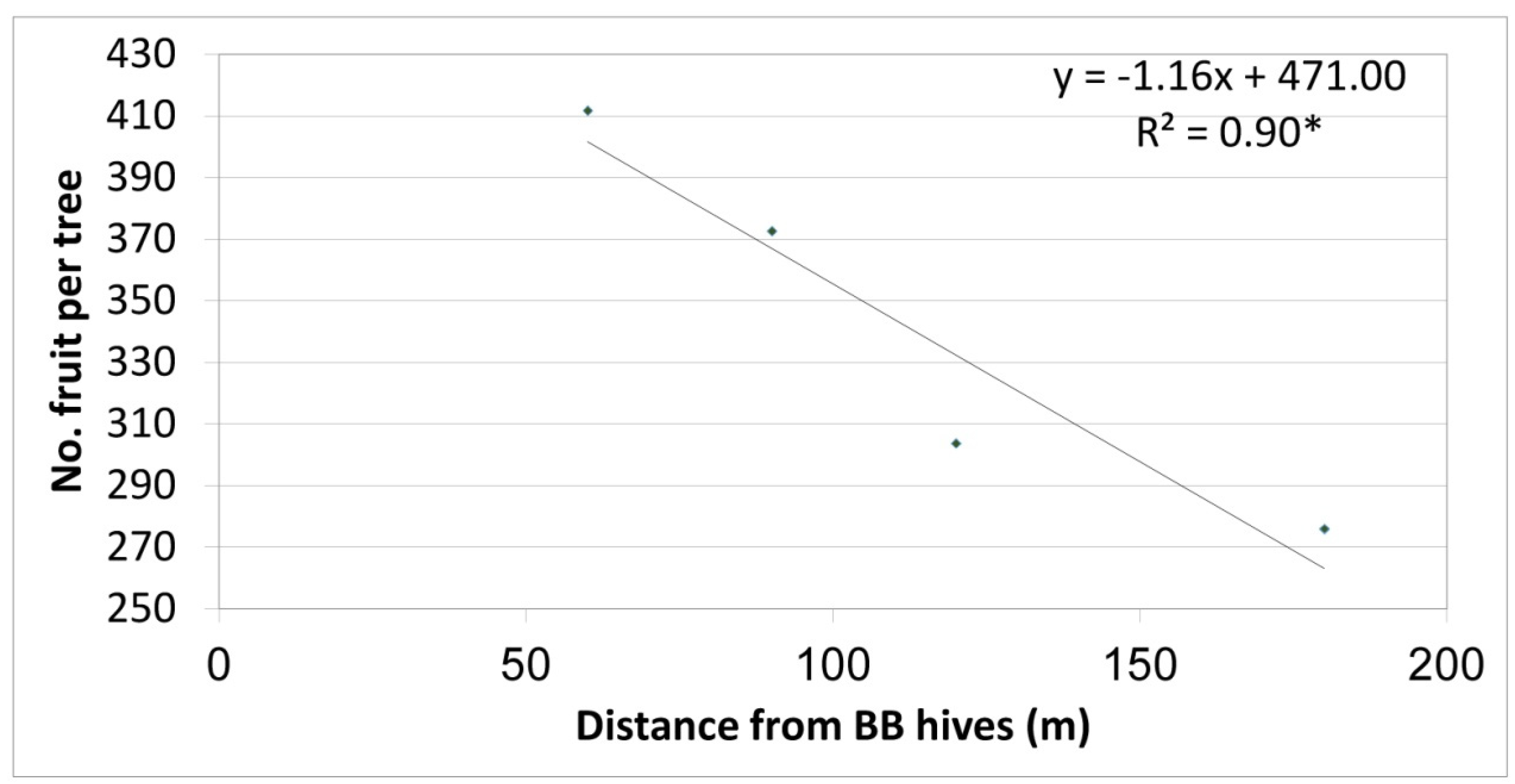
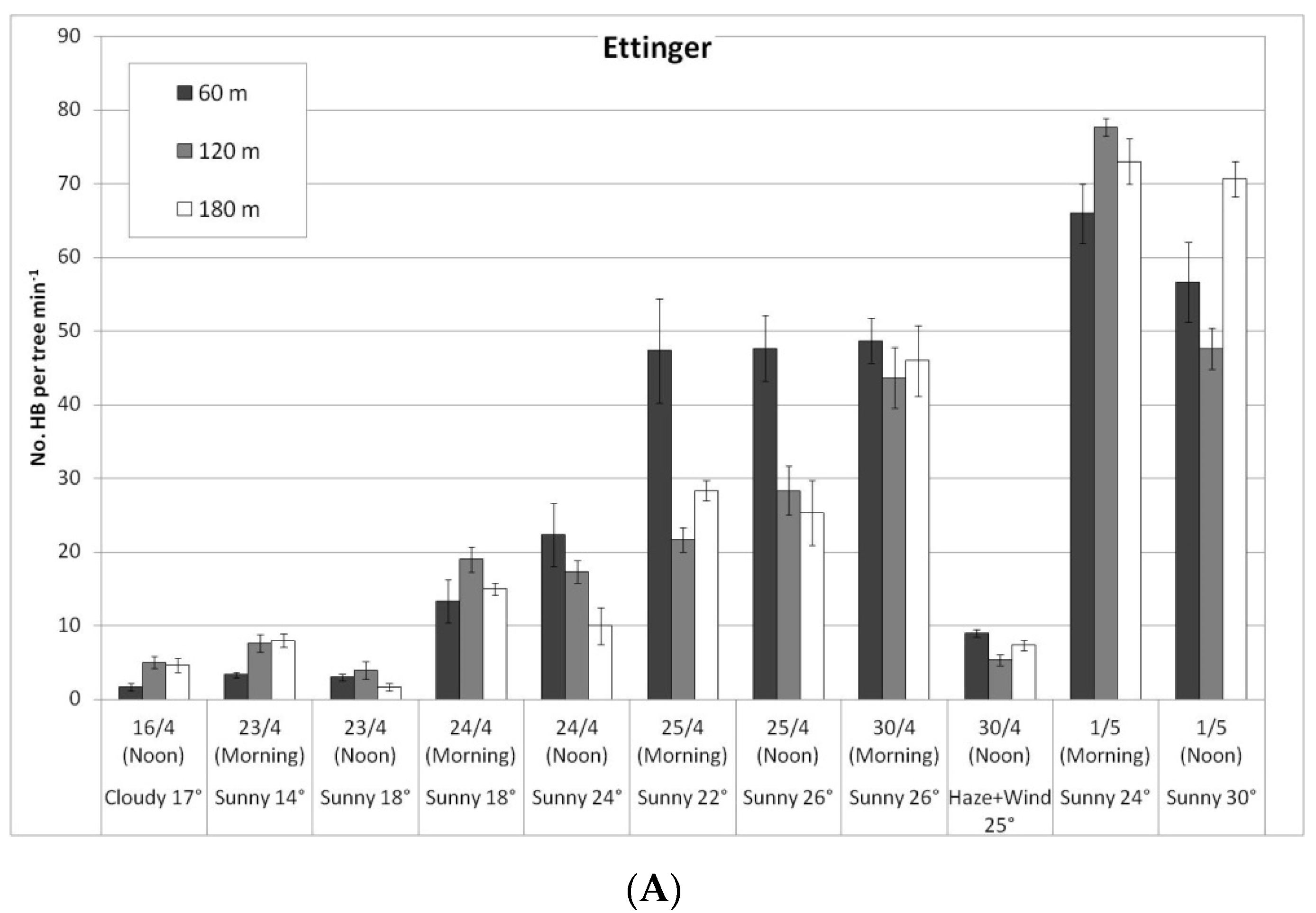
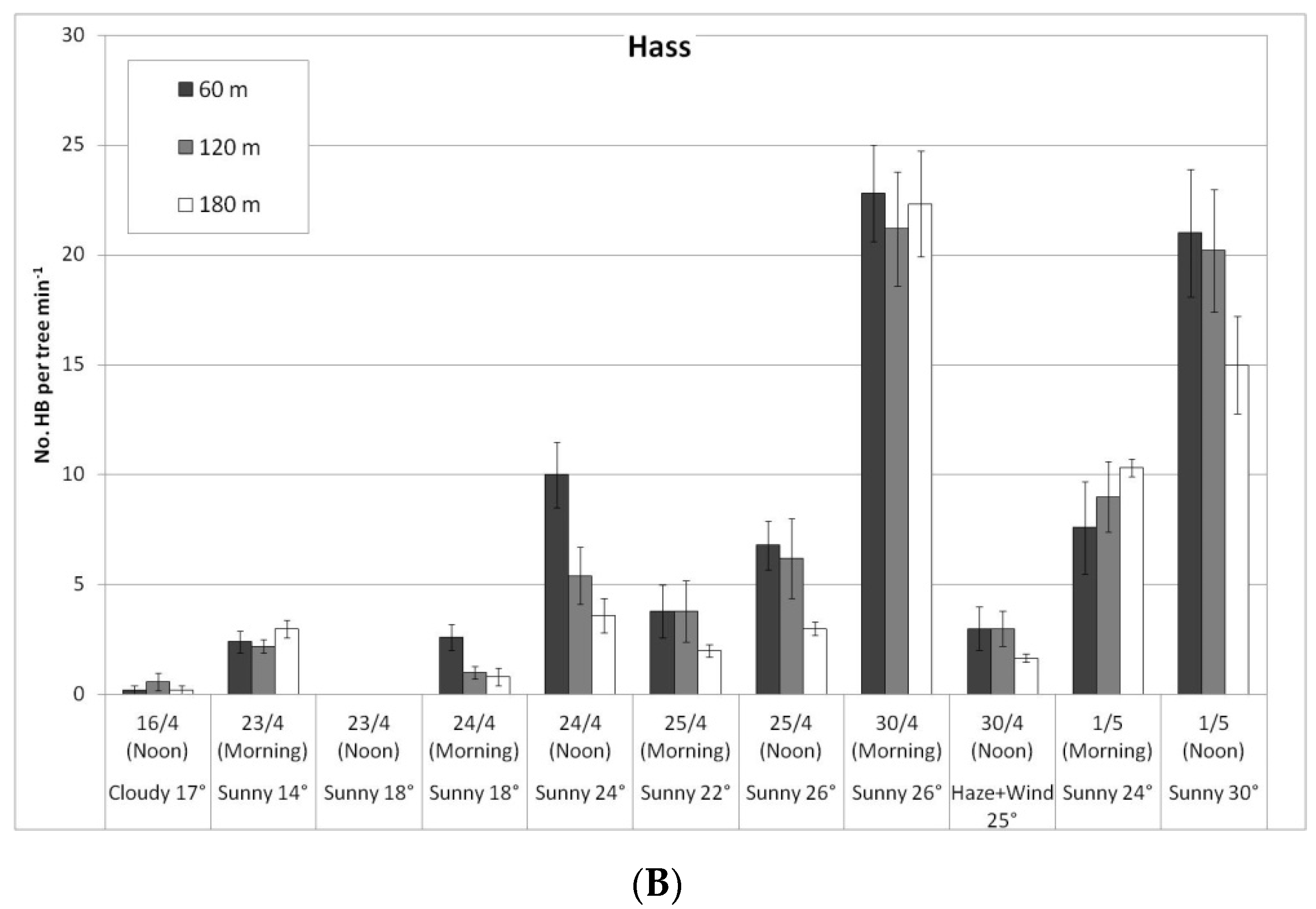
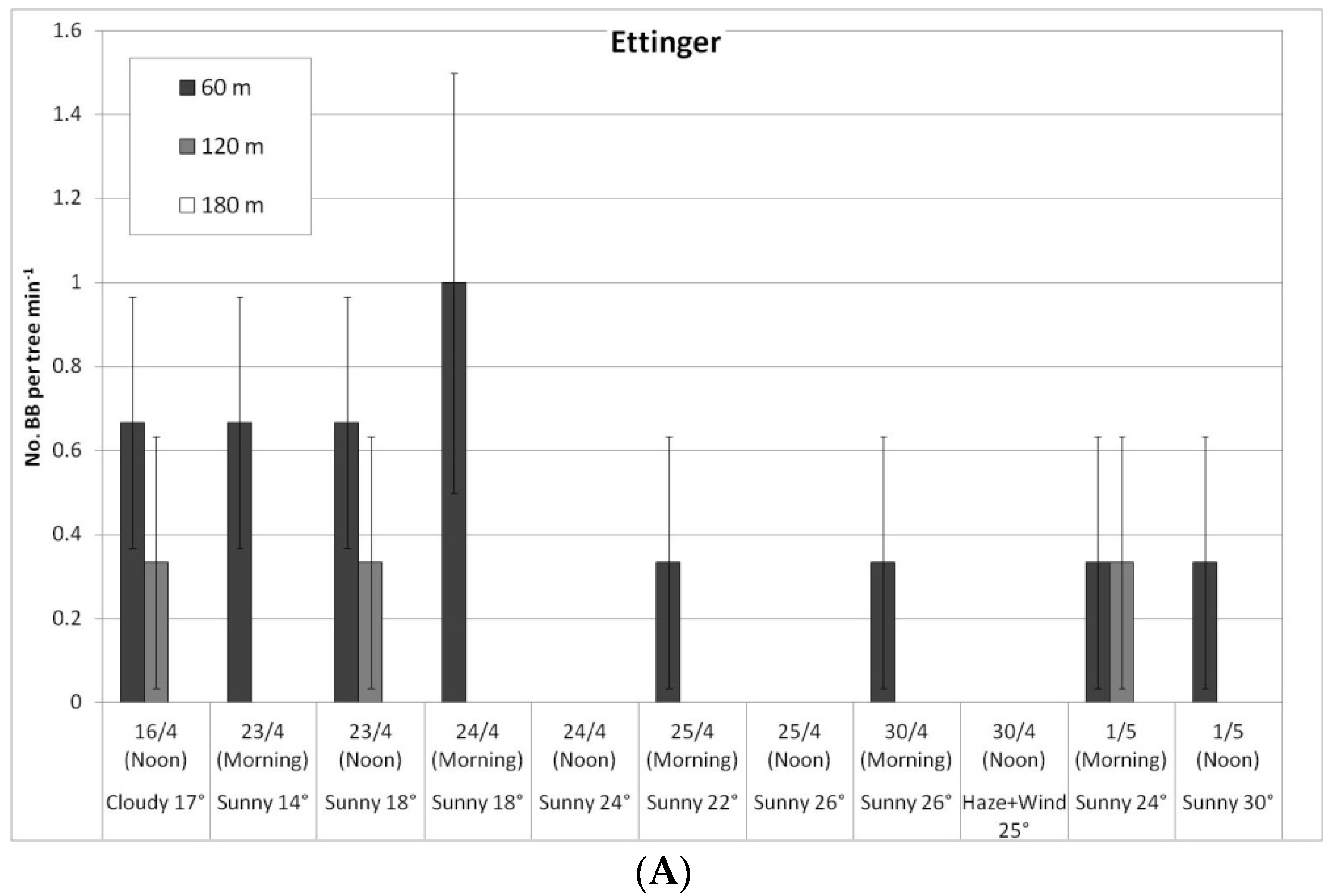
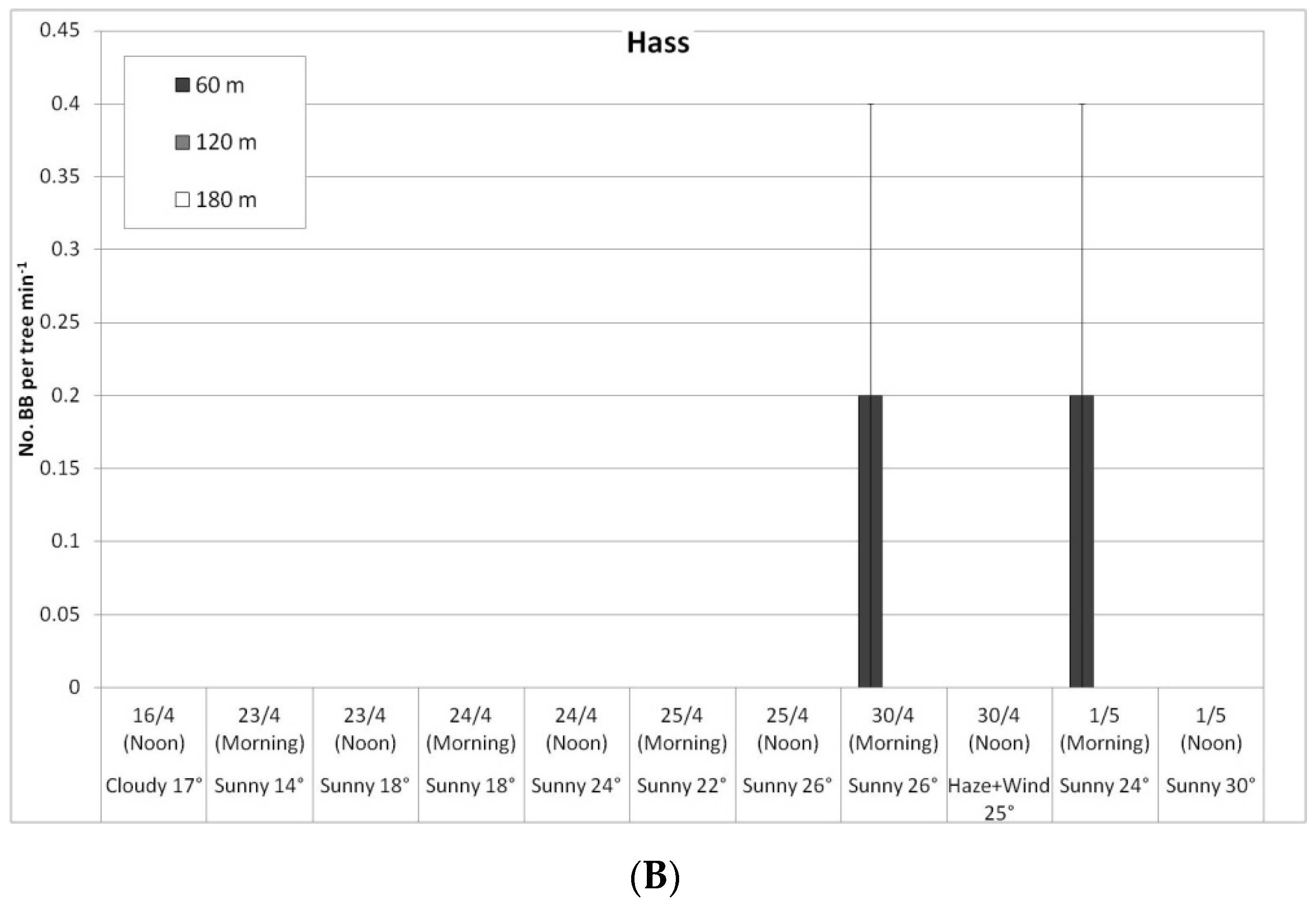
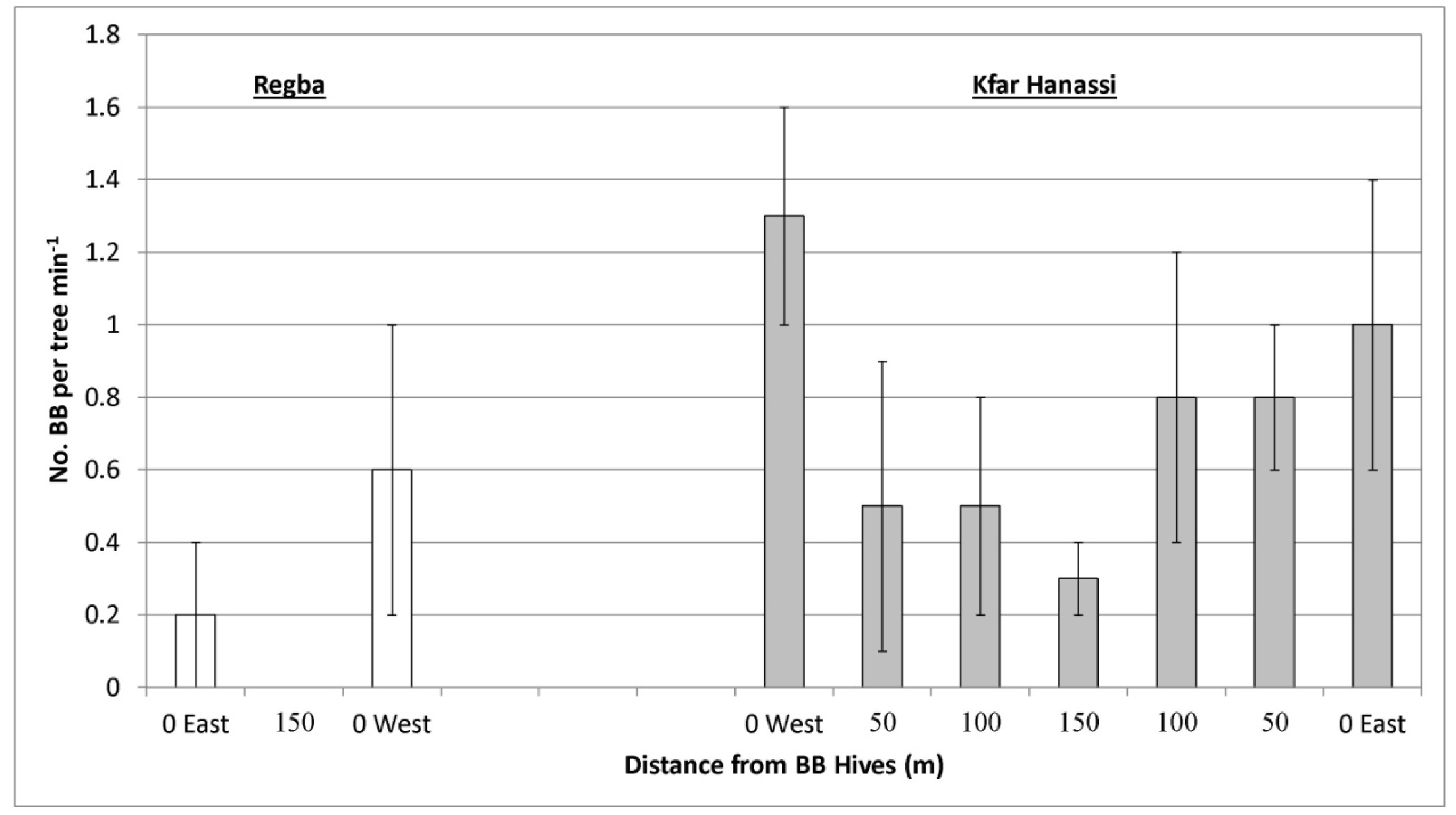

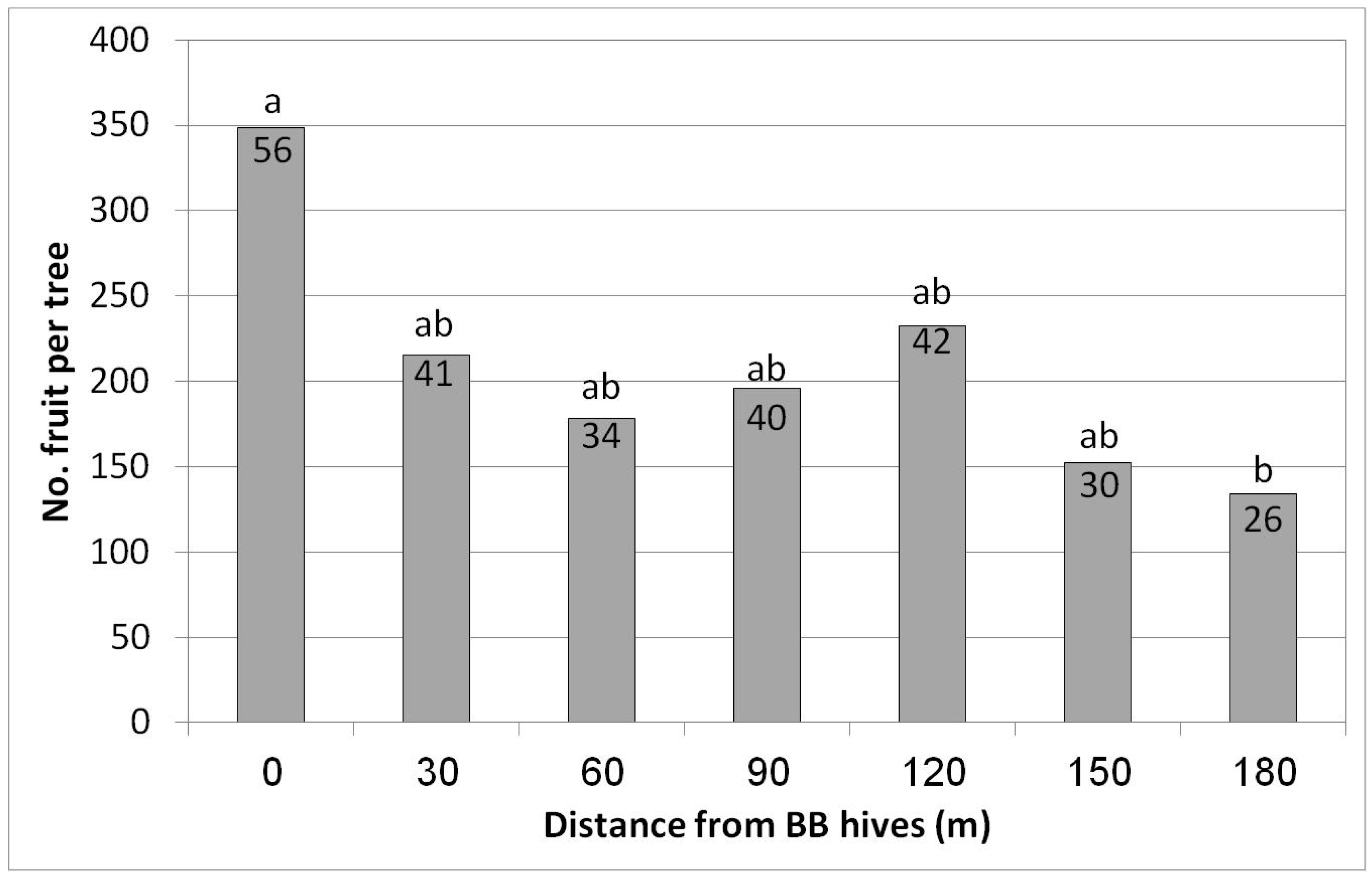

| Year | Orchard | Location | Orchard Design and Tree Data | BB Design | |||||
|---|---|---|---|---|---|---|---|---|---|
| Tree Spacing (Rows × Trees) (m) | Trees/ha (No.) | Ettinger: Hass Ratio | Age (Years) | Height (m) | BB Density (Hives/ha) | BB Hive Location (One or Two Sides of the Plot) 3 | |||
| 2017/18 | Kfar Giladi | Upper Galilee | 6 × 4 | 420 | 1:4 1 | 6 | 4 | 8 | 1 |
| 2018/19 | Kfar Giladi | Upper Galilee | 6 × 4 | 420 | 1:4 1 | 7 | 5 | 8 | 1 |
| Kfar Hanassi | Hula Valley | 6 × 4 | 420 | 1:9 2 | 15 | 6 | 8 | 1 | |
| Regba | Western Galilee | 7 × 4 | 350 | 1:4 1 | 10 | 6 | 10 | 1 | |
| 2019/20 | Kfar Giladi | Upper Galilee | 6 × 4 | 420 | 1:4 1 | 8 | 6 | 8 | 1 |
| Kfar Hanassi | Hula Valley | 6 × 4 | 420 | 1:9 2 | 16 | 6 | 12 | 2 | |
| Regba | Western Galilee | 7 × 4 | 350 | 1:4 1 | 11 | 6 | 12 | 2 | |
| Eyal | Central Israel | 7 × 4 | 350 | 1:9 2 | 6 | 4 | 5 | 1 | |
| Pollinator | Cultivar | Distance from BB Hives | Total Average | |
|---|---|---|---|---|
| Close | Far | |||
| HB | Ettinger | 8.90 Aa | 11.00 Aa | 10.00 a |
| Hass | 1.50 Ab | 1.90 Ab | 1.70 b | |
| BB | Ettinger | 0.44 Aa | 0.10 Ba | 0.27 a |
| Hass | 0.07 Ab | 0.02 Bb | 0.05 b | |
| Distance from BB Hives (m) | No. Fruit/Tree | Fruit Weight (g) | Yield | |
|---|---|---|---|---|
| kg/Tree | ton/ha 1 | |||
| 20 | 496 a | 219 a | 108 a | 45 a |
| 50 | 328 b | 232 a | 72 b | 30 b |
| 80 | 222 bc | 219 a | 48 bc | 20 bc |
| 140 | 173 c | 217 a | 38 c | 16 c |
| 170 | 202 bc | 219 a | 43 bc | 18 bc |
| 230 | 232 bc | 208 a | 50 bc | 21 bc |
| Distance from BB Hives | No. Fruit/Tree | Fruit Weight (g) | Yield | ||
|---|---|---|---|---|---|
| Name | m | kg/Tree | ton/ha 1 | ||
| Close | 30–70 | 492 a | 158 a | 76 a | 32 a |
| Medium | 100–200 | 406 ab | 169 a | 67 ab | 28 ab |
| Far | 230–270 | 335 b | 167 a | 55 b | 23 b |
| Distance from BB Hives | No. Fruit/Tree | Fruit Weight (g) | Yield | ||
|---|---|---|---|---|---|
| Name | m | kg/Tree | ton/ha 1 | ||
| Close | 30–70 | 445 a | 195 a | 85 a | 30 a |
| Medium | 100–230 | 338 b | 209 a | 68 b | 24 b |
| Far | 260–320 | 320 b | 207 a | 65 b | 23 b |
| Distance from Bumblebee Hives (m) | Pollination Rate (%) | Grains per Stigma (No.) |
|---|---|---|
| 60 | 94 | 4.5 |
| 120 | 76 | 2.5 |
| 180 | 67 | 2.1 |
| Significance | NS | * |
| Season/Orchard | Seedling Number | Distance from BB Hives (m) | Pollen Donor Identity | |
|---|---|---|---|---|
| ‘Hass’ | ‘Ettinger’ | |||
| 2018/19 Kfar Giladi | 90 (100%) | 60 | 0 (0%) | 45 (100%) |
| 240 | 2 (4.5%) | 43 (95.5%) | ||
| 2019/20 Kfar Hanassi | 89 (100%) | 50 | 1 (2.2%) | 44 (97.8%) |
| 230 | 0 (0%) | 44 (100%) | ||
Publisher’s Note: MDPI stays neutral with regard to jurisdictional claims in published maps and institutional affiliations. |
© 2021 by the authors. Licensee MDPI, Basel, Switzerland. This article is an open access article distributed under the terms and conditions of the Creative Commons Attribution (CC BY) license (https://creativecommons.org/licenses/by/4.0/).
Share and Cite
Stern, R.A.; Rozen, A.; Eshed, R.; Zviran, T.; Sisai, I.; Sherman, A.; Irihimovitch, V.; Sapir, G. Bumblebees (Bombus terrestris) Improve ‘Hass’ Avocado (Persea americana) Pollination. Plants 2021, 10, 1372. https://doi.org/10.3390/plants10071372
Stern RA, Rozen A, Eshed R, Zviran T, Sisai I, Sherman A, Irihimovitch V, Sapir G. Bumblebees (Bombus terrestris) Improve ‘Hass’ Avocado (Persea americana) Pollination. Plants. 2021; 10(7):1372. https://doi.org/10.3390/plants10071372
Chicago/Turabian StyleStern, Raphael A., Ada Rozen, Ravit Eshed, Tali Zviran, Isaac Sisai, Amir Sherman, Vered Irihimovitch, and Gal Sapir. 2021. "Bumblebees (Bombus terrestris) Improve ‘Hass’ Avocado (Persea americana) Pollination" Plants 10, no. 7: 1372. https://doi.org/10.3390/plants10071372
APA StyleStern, R. A., Rozen, A., Eshed, R., Zviran, T., Sisai, I., Sherman, A., Irihimovitch, V., & Sapir, G. (2021). Bumblebees (Bombus terrestris) Improve ‘Hass’ Avocado (Persea americana) Pollination. Plants, 10(7), 1372. https://doi.org/10.3390/plants10071372





